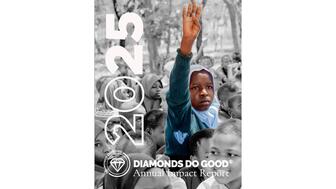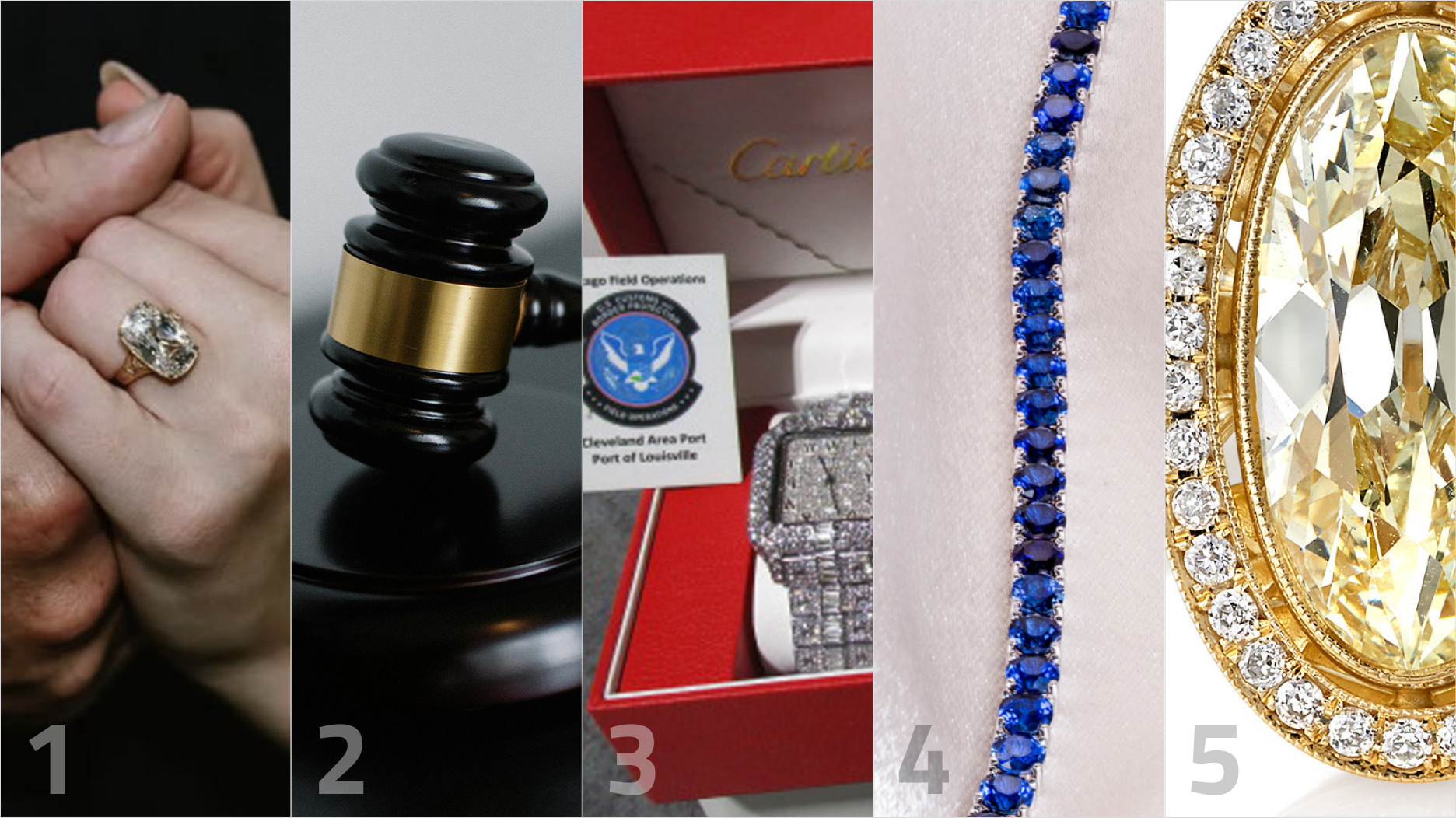As the shopping mall model evolves and online retail grows, Smith shares his predictions for the future of physical stores.
Precious and imperial topaz from Brazil
Brazil produces more topaz than any other country in the world. Most of the production is colorless, which is irradiated and heated into various shades of blue. Precious and imperial topaz offer a rare and warmer alternative to the cool blue shades we are accustomed to seeing in jewelry stores. “Precious” topaz usually refers to yellow to orange colors while “imperial” topaz usually refers to pinkish-orange to pink to purple and even red colors (see figs. 1 and 6). However, some dealers argue that all topaz in these warmer hues should be classified as imperial. Since the origin of the word topaz is most likely from the Sanskrit word “tapas,” meaning fire, this argument seems to have merit. Recent price increases are due to limited mining, renewed interest from designers in these warmer hues and strong domestic demand in Brazil.

Fig.1: Precious and imperial topaz from Ouro Prêto, Brazil (Gems from 5 carats to more than 62 carats)
Center: Classic orthorhombic crystal with prismatic termination (102g). Photo: E. Boehm, RareSource
No visit to Brazil would be complete without stopping by the famous gold mining region of Ouro Prêto, “Black Gold” in reference to the black rock in which gold was first discovered there during the Brazilian gold rush of the early 18th century. Today, this beautifully preserved colonial Portuguese city is a UNESCO World Heritage Site and the world’s only source for imperial topaz.
Ouro Prêto, while built on gold mining, is today more famous for precious and imperial topaz, which was also discovered here in the early 1700s. The topaz mines are located just a short drive outside the city so it is possible to visit them in a few days. Getting there is easier if one flies through the closest major airport in Belo Horizonte, which is only a two- to three-hour drive from Ouro Prêto.
The two main large-scale mines of Capão and Vermelhão produce the majority of all material on the market today but there are also several small-scale mines operated by independent artisanal miners known as Garimpeiros. Vermelhão is the Portuguese word for vermilion in reference to the reddish-orange to red topaz crystals found there. All the mines are open-pit operations that use water to separate the gem crystals from the weathered host rock.


Fig.2: Washing grate (top left) used for the initial separation of host rock and gem-bearing ore, which flows down the slope to the rolling jig that further separates the gems from the ore. Capão Imperial Topaz Mine, Brazil.
Photo: E. Boehm, RareSource
Fig.3: Fine topaz crystals (top right) displaying the orange to sherry range of color found at the Capão mine in Ouro Prêto, Brazil. Photo: E. Boehm, RareSource

Geology
Topaz is an alumina-silicate that typically forms in granitic pegmatites or rhyolitic igneous rocks. Imagine a molten volcanic material that travels from the lithosphere deep in the earth through the asthenosphere and ultimately into the Earth’s crust. This molten material either migrates up as a large plutonic mass, or squeezes into weaker fractured areas within the earth’s crust creating pegmatites, or explodes out in the form of a volcanic rhyolite. Once it

Fig.5: Topaz crystals in host rock from the Vermelhão Mine in the Saramenha district of Ouro Prêto within the state of Minas Gerais, Brazil. Photo: E. Boehm, RareSource
Gemology
The basic chemical formula for topaz is Al2(SiO4)(F,OH)2. Precious and imperial topaz gets its colors from trace amounts of chromium (Cr+3). It has a relatively high hardness of eight on the Mohs scale, which is the same as spinel. Like diamond, it has one direction of perfect cleavage so care must be taken to avoid hard blows. Its relatively high refractive index (1.61-1.63) and excellent transparency make topaz one of the most versatile and desirable gems. Like tanzanite and chrysoberyl, topaz is no-axial which means it has two optic axes and three optical directions through which light travels at different speeds. These three optical directions represent the three refraction indices of topaz. This also means that each direction has a different absorption producing different colors. Blending these colors in the faceting process is a true art and can produce amazingly varied results, particularly in precious and imperial topaz. Topaz typically contains two-phase inclusions (liquid and gas), three-phase inclusions (crystal, liquid and gas), or multi-phase inclusions (crystals, liquids and gas). These multi-phase inclusions are a result of the hydrothermal phase during which crystal growth occurs.

Graduate Gemologist (G.G.) Edward Boehm is the owner of RareSource (formerly JOEB Enterprises), a Chattanooga, Tenn.-based gemstone supply and consultancy. RareSource travels to mines worldwide to bring customers the finest quality gemstones. Contact him at edward@raresource.com. For those attending the Tucson show next month, please feel free to drop by the RareSource booth #406 at the AGTA show.
The Latest

The trade show is slated for Jan. 31-Feb. 2 at The Lighthouse in New York City's Chelsea neighborhood.

January’s birthstone comes in a rainbow of colors, from the traditional red to orange, purple, and green.

How Jewelers of America’s 20 Under 40 are leading to ensure a brighter future for the jewelry industry.

The annual report highlights how it supported communities in areas where natural diamonds are mined, crafted, and sold.


Footage of a fight breaking out in the NYC Diamond District was viewed millions of times on Instagram and Facebook.

The supplier has a curated list of must-have tools for jewelers doing in-house custom work this year.

Roseco’s 704-page catalog showcases new lab-grown diamonds, findings, tools & more—available in print or interactive digital editions.

The Signet Jewelers-owned store, which turned 100 last year, calls its new concept stores “The Edit.”

Linda Coutu is rejoining the precious metals provider as its director of sales.

The governing board welcomed two new members, Claire Scragg and Susan Eisen.

Sparkle with festive diamond jewelry as we celebrate the beginning of 2026.

The master jeweler, Olympian, former senator, and Korean War veteran founded the brand Nighthorse Jewelry.

In its annual report, Pinterest noted an increase in searches for brooches, heirloom jewelry, and ‘80s luxury.

Executive Chairman Richard Baker will take over the role as rumors swirl that a bankruptcy filing is imminent for the troubled retailer.

Mohr had just retired in June after more than two decades as Couture’s retailer liaison.

Shekhar Shah of Real Gems Inc. will serve as president of the Indian Diamond & Colorstone Association in 2026.

This year’s good luck charm features the mythical horse Pegasus, and is our first Piece of the Week of the new year.

As part of the leadership transition, Sherry Smith will take on the role of vice president of coaching strategy and development.

It marks the third time the country has headed the Kimberley Process. Ghana will serve as vice chair.

The new Bulova x Stetson designs highlight two animals often associated with the American West—the bison and the Texas Longhorn.

Its residency at Yamron Jewelers will run through May 2026.

From influential executives to innovative designers, we pay tribute to the people we said goodbye to this year.

The retailer is expanding into areas with large Indian and South Asian populations.

The Italian brand has opened its first flagship amid the peaks of the Dolomites in Madonna di Campiglio, Italy.

The new curation at the Natural History Museum of Los Angeles County showcases rare gem and mineral specimens in their uncut, natural state.

The couple pleaded guilty to concealing at least $127 million in cash transactions at its precious metals businesses.




























